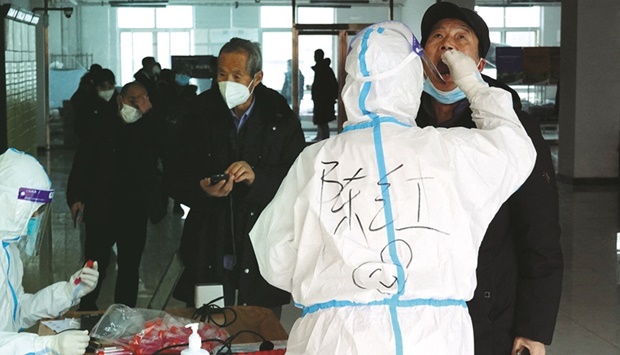Hundreds of thousands more people were confined to their homes in northern China yesterday as the country battled its worst Covid surge in 21 months and locked-down residents took to social media to complain about food shortages.
China — where the virus emerged two years ago — has followed a “zero-Covid” strategy of tight border restrictions, lengthy quarantines and targeted lockdowns as Beijing prepares to welcome thousands of overseas visitors to February’s Winter Olympics.
But authorities have faced a resurgent virus in recent weeks, reporting 209 infections yesterday — the highest single-day tally since March last year, when the pandemic raged through the central city of Wuhan. The surge — while low in comparison to rampant cases in Europe and the United States — has prompted authorities to impose what they have called the “strictest” possible curbs in the northern city of Xi’an, whose 13mn residents are entering a sixth day of home confinement.
As well as having undergone several rounds of testing, households are limited to sending out one person every three days to buy groceries.
Nearby cities have also logged cases linked to the flare-up, with Yan’an — about 300km from Xi’an — yesterday shuttering businesses and ordering hundreds of thousands of people in one district to stay indoors.
The Xi’an lockdown is the most sweeping in China since the similarly-sized Wuhan was sealed off. More than 800 coronavirus cases have been recorded in Xi’an since December 9, with the youngest case a 38-day-old infant, the state-run ‘Global Times’ newspaper reported yesterday.
Case numbers in Xian are small compared with many clusters in other countries, but Chinese officials have imposed tough curbs on travel within the city and on leaving it, in line with national guidelines to immediately contain any Covid-19 outbreak.
Some residents in Xian were anxious to know when they could next stock up on daily necessities such as vegetables, as officials had barred people from going out to shop during a new round of mass testing that started on Monday. Officials had said shopping could resume for people in less risky areas once test results came back negative, but did not say exactly when the suspension would be lifted. Prior to the restriction, each household had been allowed to send only one person out to shop for essentials every two days. “It feels like a long time,” said a 22-year-old resident surnamed Jin.
“The fact that I haven’t yet been told when I could shop again makes me a bit anxious,” Jin, who ran out of fresh greens by yesterday and couldn’t make orders online without waiting for nearly a week before delivery, told Reuters.
Since last week, Xian residents have not been allowed to leave the city without clearance from their employer or community authorities.
Officials have also banned non-essential vehicles. Zhang Boli, who advised the Chinese government in formulating early Covid-19 response and treatment strategies, told state media earlier this month that Xian may contain the outbreak by around mid-January.
Nationwide, mainland China detected 182 local symptomatic cases for Monday, according to a statement by the National Health Commission, compared with 162 a day earlier.
That was the highest daily count since the official daily bulletin started classifying asymptomatic cases separately at the end of March last year.
China has disclosed only a handful of Omicron infections, mostly among international travellers and in the south. A national health official said earlier this month that local transmission caused by imported Omicron infection was found in the southern city of Guangzhou, without disclosing how many cases were found. An infectious disease doctor in the eastern province of Zhejiang said yesterday at a government-organised news briefing that Omicron cases arriving from overseas were detected in the province a week ago, without disclosing the number of infections. In Xianyang — a nearby city of 4mn with around a dozen cases — the local Red Cross branch appealed to the public for cash donations, saying its “consumption and demand for protective gear is currently very large”.

A medical worker in protective suit collects a swab sample from a man for nucleic acid testing at a residential compound, during another round of mass testing following the Covid-19 outbreak in Xian, Shaanxi province, China.
